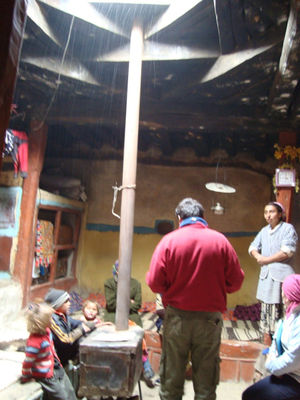Knowledge fuels change
For over a decade, Energypedia has shared free, reliable energy expertise with the world.
We’re now facing a serious funding gap.
Help keep this platform alive — your donation, big or small, truly matters!
Thank you for your support
Heating - Indoor Air Temperature
--> Back to Overview GIZ HERA Cooking Energy Compendium
Introduction
Human beings require a certain level of ambient air temperature in order to remain healthy. The mortality rate due to respiratory diseases, high blood pressure, and stroke risks increases when room temperatures fall below 20°C (Poor People´s energy outlook 2010, page 18). The international energy access debate suggests a minimum standard of daytime indoor air temperature of 12°C up to 18°C (PPEO 2010, page 33 and Defining Energy Access – proposed updated indicators http://www.hedon.info/tiki-download_forum_attachment.php?attId=23).
In many parts of this world, there are no problems in respect to these recommendations without the need for specific actions. However, in other areas – mainly in high altitude regions and the temperate zone – indoor air temperatures cannot be maintained on the required level without specific interventions. Examples for such geographic regions in developing countries are the South American Andes, the mountainous regions of Central Asia (Pamir, Himalaya, Alai, Tienshan) and the Atlas mountains in Morocco.
Indoor air temperature and therefore respective needs for heating is influenced by climate seasonality (duration of winter month) and altitude. Estimations by Hulscher et al. (FAO, 1997) indicate, that half a billion people in South and South-East Asia alone use stoves for space heating, whether as an absolute daily necessity in the coldest climates or for comfort during cooler seasons or at night.
Indoor air temperature is an important factor for a large number of populations. An overall number of households with needs to maintain an adequate indoor air temperature in developing countries is not estimated so far. Respective needs for maintaining indoor air temperature, like heating, contributes to energy poverty and it is linked to a number of Millenium Development Goals, as the following:
- Education (MDG 2) – indoor air temperature in social and public buildings, such as schools and hospitals,
- Gender quality and empower women (MDG 3),
- Health (MDG 4 and 5), and
- Environmental sustainability (MDG7) – due to fuel consumption and emission for heating.
|
|
Picture: In the high mountains of Nepal, households use an open fire for cooking and heating purposes indoor. Besides, the high needs for fuel wood, the indoor air temperatures are insufficient during the winter, and the exposure to smoke causes serious respiratory diseases and injuries caused by the open fire. (Source: Christoph Messinger, GIZ) |
Despite this high importance and relevance of indoor air temperature, it has been so far not adequately addressed in the field of development cooperation.
Though there is a lot of knowledge available in developed countries, for example on thermal insulation and efficient and cleaning heating stoves, little experience and knowledge are available on appropriate solutions for developing countries. This results in little available information on fuel demand and supply, technical heating stove designs, additional technical measures like house improvements and dissemination approaches for affordable, acceptable and accessible solutions in developing countries.
|
|
Picture: A house in the Western part of the Pamirs in Tajikistan, showing the typical construction of the Pamirian house. The hole in the roof, which is traditionally determined, is not closed because of missing finances and knowledge. Thus heat from the stove is leaving the room immediately and snow and cold air enter the room the whole winter season during day and night. (Source: Heike Volkmer, GIZ) |
Commonly, “space heating” is the core activity associated with the necessity to alleviate room temperatures. However, there are a number of different factors influencing indoor air temperature, such as:
- Housing conditions, e.g. construction, thermal insulation
- Fuels for space heating (quality and quantity)
- Space heating devices, e.g. traditional heating stove, improved heating stoves, multi-purpose stoves, heat exchanger
- User behaviour, e.g. fuel processing, use of oven, ventilation habits
Each of the factors will be described in the following chapters.
Housing conditions
The effect
Top of the page





















